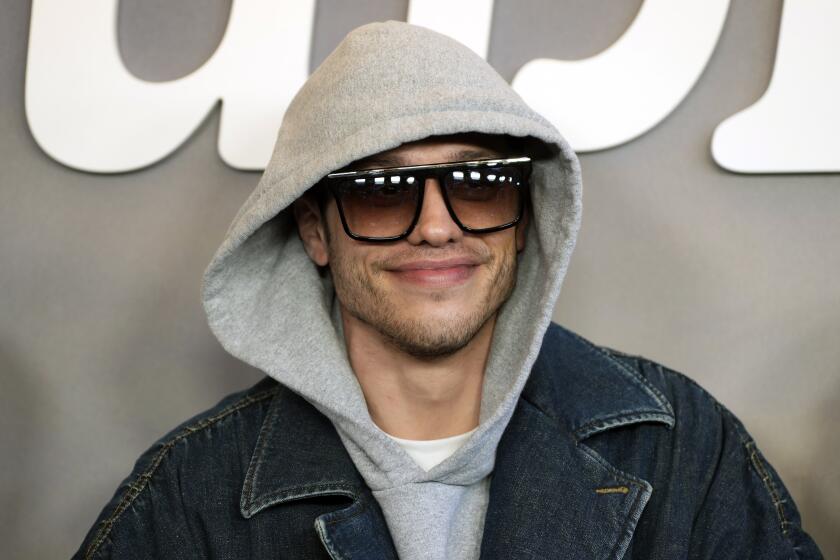Blaxploitation cinema: Can you dig it?
Michael Jai White remembers the first time he saw people onscreen who looked like they came from his ‘hood. This was in an otherwise forgettable 1976 blaxploitation flick called “The Monkey Hustle” starring Yaphet Kotto and Rudy Ray Moore as street-smart con men trying to stop the Man from demolishing their neighborhood for a freeway project. It may not have been high art, but in its own sneaky way, “The Monkey Hustle” was truly glorious.
“It was just brash, unlike anything I’d ever seen,” says White, the co-screenwriter and star of “Black Dynamite,” a spoof of ‘70s-era black action pictures that opens Friday. “I remember these bigger-than-life characters, who reminded me of my uncles, and it was the first time I saw anything familiar in my life on the big screen.”
Say what you will about the roughly 150 black action, horror and comedy films that came out between 1971 and 1976, the height of the blaxploitation era: that they were cheaply made, poorly acted, hyper-violent and glorified pimps, prostitutes, criminals and con men -- all those things are true, to a certain extent. But they were also utterly empowering, gobbled up by African American audiences desperate for strong, and recognizable, working-class heroes.
“These films made me feel proud in a way Sidney Poitier didn’t; he was detached from the inner-city experience,” says Josiah Howard, author of “Blaxploitation Cinema: The Essential Reference Guide.”
“These people spoke to me because they spoke like me, they looked like me, they had simple dreams like me,” Howard says. “I came to these films as a young teen, and I could not believe I was seeing people like me, with big Afros, living in the ghetto. I thought, ‘That’s my life,’ so it was uplifting for me.”
“We needed heroes” at the time, agrees Fred “The Hammer” Williamson, who starred in “Black Caesar,” “Hell Up in Harlem” and many other black action pictures. “Sidney Poitier was a great actor, but he did not fulfill the void of how some blacks interpreted their impact on society. We needed something to propel the masculinity of the black male, and black women were tired of the Aunt Jemima character. They had the same needs we did.”
--
Beyond Poitier
Before “Shaft,” “Superfly,” “Slaughter,” “Coffy” and “Cleopatra Jones,” in fact, Poitier was pretty much the only viable black film star, featured in roles in which he was often the African American version of a straight shooting -- and sexless -- Boy Scout. Then in 1971, along came writer-director Melvin Van Peebles, whose independently produced and distributed “Sweet Sweetback’s Baadasssss Song,” about a street hustler on the run from the law, grossed a then-astonishing $4 million (about $21 million in today’s dollars).
Right after that, the studio-produced “Shaft” upped the ante with a $12 million gross ($63 million today), which opened the floodgates to scores of films made for black audiences, starring black actors and often written and directed by black talent.
“These were simply films that would appeal to a black audience,” says Jack Hill, who directed “Coffy,” “Foxy Brown” and other films of the era. “The producers felt if you made a film for a certain budget [usually under $1 million], you were guaranteed to make a profit just from the black audience.”
Yet even though they were often made as cheaply produced programmers, the B pictures of their era, blaxploitation films -- the term, a combination of black and exploitation, was coined by Junius Griffin, then head of the Los Angeles NAACP -- also captivated because of their ghetto style, talented casts -- Jim Brown, Richard Roundtree, Pam Grier, Rosalind Cash, Paul Winfield, Bernie Casey, Robert Hooks -- and their willingness to take on contemporary social issues.
“They dealt with the universals of the time,” Hill says. “The Vietnam War, that it was a racist operation, and the cannon fodder were blacks and Latinos. Also the social concern that there was still a lot of racism in the country, the kind that was not so overt. And of course your universal themes of love, hate, betrayal and revenge, the basic elements of drama, adapted to the black community.”
--
Takin’ it to the Man
White, whose film is about an African American superhero -- the Black Dynamite of the title -- tracking down a plot by the Man to quite literally shrink black male sexuality, sees his film as a sort of tip of the hat to that era, a way to declare his “love for the period,” although as a comedy, “Black Dynamite” “has fun with films in general,” White says. “It’s funny to do it as a time capsule and lay in some jokes that are only funny when you’re looking at them now. You look at the ‘70s, is there a more entertaining time? That time period was so alive. It was a great time for black people -- they went from their heads being bowed to being up and strong.”
But it was a newfound strength sometimes taken to extremes.
“There was an obvious over-compensation of the hyper-violence,” White says, “which came from being oppressed. They were hyper-violent in the ways in which they dealt with racism; white people were depicted as evil. But they also reflected the paranoia of the time, there was a mistrust of government, and a lot of movies, not only black movies, reflected that.”
But toward the end of the decade, when “Star Wars” and “Jaws” hipped Hollywood to the joys of the blockbuster film, blaxploitation all but disappeared from the scene. Yet it lives on in homages like “Black Dynamite” and quasi-blaxploitation mainstream films such as Quentin Tarantino’s 1997 feature “Jackie Brown,” which stars blaxploitation goddess Grier. But whether the genre has had a lasting influence is a subject of controversy.
Hill feels there has been a positive effect, particularly for black actors. “When blaxploitation films began to attract a universal audience,” he says, “it showed the bean counters that there was a universal interest in black characters and lifestyle. The major studios began incorporating these elements, so the blaxploitation films no longer became necessary.”
Yet Williamson, who never liked the term “blaxploitation” -- “If you could call my films blaxploitation, why couldn’t you call Clint Eastwood’s films, or Burt Reynolds’ films, white exploitation?” he asks -- feels that despite all the talent that worked in the genre, in terms of behind-the-camera gigs, “it’s made no difference whatsoever. We have no impact. We’re at the mercy of the major studios to hire us.”
Howard believes that ‘70s cultural references have stuck with us -- afros are popular again, and there are countless music videos that reference “Superfly” and “The Mack” -- but as far as opening industry doors is concerned, “certainly some more people came [in], but it was begrudging. It didn’t make a long-lasting impact.”
And there’s a bigger issue: White wonders where the Jim Browns and Fred Williamsons of today are. Noting that “many of the black leading characters are usually coming from comedy or rap,” and that other than Denzel Washington, Samuel L. Jackson and Will Smith there are few African American actors who can be considered leading men (not to mention the almost total absence of black female leads), Howard asks, “Where’s our George Clooney? There are not many people who are representative of the black alpha male today. Once the mid-’70s and the blockbuster came around, Hollywood had no more use for these black action stars.”
Williamson adds, “We were fulfilling the need of a public that was starving for a different kind of product, and the void is still there.”
Now, he adds, the studios’ idea of filling the void “is to put Samuel Jackson or Denzel in every picture. And Tyler Perry’s movies succeed because there is nothing else. If that’s all you have, you support it. But we’re gonna get tired of Tyler Perry. He has to have a son who goes to high school and kicks some ass.”
--
--
(BEGIN TEXT OF INFOBOX)
Talkin’ the talk
Interested in the key elements that made up the blaxploitation genre? Check ‘em out, my brother.
THREADS
Wide-collared shirts and suit jackets, wild prints, polyester and more polyester for the men. More wild prints, short skirts, pantsuits, body-hugging lounge outfits and cleavage-baring tops for the women. Dashikis for both sexes. The look veered from disco-licious to totally pimped out to Black Panther chic. See “Superfly,” “The Mack” and “Cleopatra Jones” for style points.
‘FROS
The most glorious era for the afro. Wild and mangy, clipped and caressed, often big as a planet, always a “black and I’m proud” statement. Catch Pam Grier in “Foxy Brown” or Tamara Dobson in “Cleopatra Jones” for Afro Sheen looks.
THE MAN
As in doin’ it to, stickin’ it to, getting back at. Generally, a reference to the white power structure but could be used as a signifier for anyone keeping the black community down. Almost every blaxploitation villain was a version of the Man.
BRINGIN’ ON THE FUNK
Wah wah guitars, funkified beats, orchestral overdrive. Blaxploitation soundtracks sure pulled out all the stops.
LOW FIVES
The way to greet a brother. The high five came later.
THE SLANG
Can you dig it? Yo momma. Honky. Bad (as in good). Outta sight. Jive. Super-bad, super-hot, super-cool, super-fly. Sucka. Uptight. Keep the faith. Pig (as in cop). Ain’t no thang. And numerous terms that cannot be printed in a family newspaper. Hipster talk was never more colorful.
-- Lewis Beale
--
latimes.com/entertainment
See a gallery of photographs from blaxploitation movies.
More to Read
Only good movies
Get the Indie Focus newsletter, Mark Olsen's weekly guide to the world of cinema.
You may occasionally receive promotional content from the Los Angeles Times.










